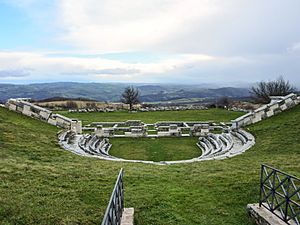Province of Isernia facts for kids
Quick facts for kids
Province of Isernia
Isernia
|
|
|---|---|
 |
|
| Country | |
| Region | Molise |
| Capital | Isernia |
| Area | |
| • Total | 1,529 km2 (590 sq mi) |
| Population
(2001)
|
|
| • Total | 89,775 |
| • Density | 59/km2 (150/sq mi) |
| Postal Code |
86070-86071, 86073-86080, 86082-86099, 86170
|
| Telephone prefix |
086, 0865, 0874
|
| ISTAT | 094 |
| Vehicle registration | IS |
| No. of communes | 52 |
The Province of Isernia (which is provincia di Isernia in Italian) is a cool area in the Molise region of Italy. Its main city and capital is Isernia. This province is led by a president and is home to 52 different towns and villages, called comuni in Italian. It covers about 1,535.24 square kilometers (592.76 square miles) and has around 86,405 people living there as of 2016.
Contents
A Look Back: History of Isernia
Ancient Times and Roman Rule
Isernia was once known as Samnite Aesernia. This was before it became part of the Roman Republic in 263 BC. Later, a leader named Alczeco received land here for helping fight against the Byzantines. Most of this land became Molise County.
Challenges and Rebuilding
During the 800s, the area faced many challenges. Muslim groups attacked the region several times. A big earthquake in 847 also caused a lot of damage. It destroyed the cities of Isernia and Venafro. Even with these problems, Isernia became an important religious center. It was also made a county in 964.
Amazing Discoveries and Important Figures
In 1979, archaeologists made an exciting discovery near Isernia. They found proof of a very old settlement. It dated back over 736,000 years ago, to the Paleolithic period! This shows people lived here a very long time ago.
After the Roman Empire fell in 476, a group of monks called Benedictines built the San Vincenzo al Volturno monastery in the province. When invaders attacked, many monks were sadly killed or taken as slaves. But the monastery kept going strong. It was at its biggest and best in the 1000s and 1100s.
A very important person, Pope Celestine V, was born near Isernia. The province celebrates a special feast day on May 19th. This date marks when Celestine V became a saint. In 1805, another earthquake destroyed Isernia's main church, its cathedral. It was rebuilt in 1837 on the same spot.
Exploring the Geography of Isernia
The Province of Isernia is mostly a mountainous area in central Italy. It is part of the Molise region. As you go southwest, the mountains get smaller. The wooded hills turn into flat plains around Venafro.
Neighboring Regions and Natural Features
To the northeast, you'll find the Province of Campobasso, which is also in Molise. To the north are the Province of L'Aquila and Province of Chieti. These are both in the Abruzzo region. To the west is the Province of Frosinone in Lazio. To the south is the Province of Caserta in Campania.
There are four mountain ranges in the province. The Abruzzo National Park is partly in Isernia, right on the border with Abruzzo. The highest mountain peak in the province is Monte Mare, which is 2,020 meters (6,627 feet) tall.
Rivers, Lakes, and Local Economy
The main rivers here are the Volturno and the Trigno. The Volturno flows into the Tyrrhenian Sea. The Trigno flows into the Adriatic Sea. There's also a lake called Castel San Vincenzo. It's a lake made by people to help create electricity using water power.
The economy of this region has always been based on farming. Most farms are small. They grow grapes, grains, olives, vegetables, and fruits. They also produce dairy products. Some special traditional foods grown here include grass peas and farro, which is a type of wheat. Tintilia grapes are grown to make the region's red wine, called "Tintilia del Molise."
See also
 In Spanish: Provincia de Isernia para niños
In Spanish: Provincia de Isernia para niños


